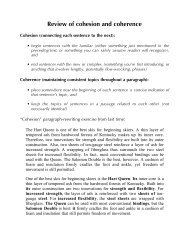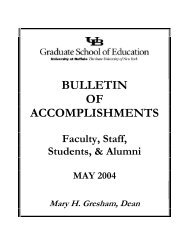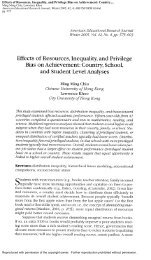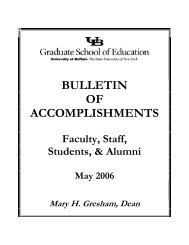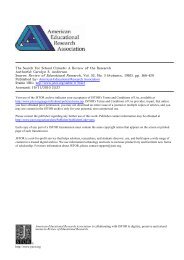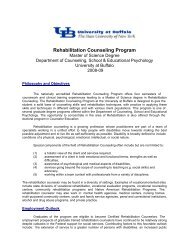Higher Education Finance and Cost-Sharing in Canada
Higher Education Finance and Cost-Sharing in Canada
Higher Education Finance and Cost-Sharing in Canada
You also want an ePaper? Increase the reach of your titles
YUMPU automatically turns print PDFs into web optimized ePapers that Google loves.
Student loans are means-tested <strong>and</strong> available to all students <strong>in</strong> public <strong>and</strong> private colleges <strong>and</strong>universities to cover tuition fees <strong>and</strong> liv<strong>in</strong>g costs. A student’s loan amount is based on them<strong>in</strong>istry’s calculation of the amount of money that the student <strong>and</strong> his/her parents should haveavailable to pay for educational <strong>and</strong> liv<strong>in</strong>g costs tak<strong>in</strong>g <strong>in</strong>to account a student’s pre <strong>and</strong> studyperiod <strong>in</strong>come <strong>and</strong> assets <strong>and</strong> parental (or spousal) <strong>in</strong>come. Most students who have more thanC$1700 [US$1,417] (C$50 [US$42] per week) <strong>in</strong> <strong>in</strong>come face a reduction <strong>in</strong> the amount ofstudent assistance available to them. After calculat<strong>in</strong>g the f<strong>in</strong>ancial need by subtract<strong>in</strong>g thisexpected contribution from total expenses, the m<strong>in</strong>istry determ<strong>in</strong>es the amount of fund<strong>in</strong>g towhich the student is entitled—but capped at a 2009-10 maximum of C$350 [US$292]/week for340 weeks.The federal <strong>and</strong> prov<strong>in</strong>cial governments pay <strong>in</strong>terest on the loans while the students are <strong>in</strong>school. Students beg<strong>in</strong> repayment after a six-month grace period follow<strong>in</strong>g graduation (<strong>in</strong>terest isaccumulated dur<strong>in</strong>g the grace period) at a fixed or float<strong>in</strong>g rate of <strong>in</strong>terest. As of October 2009,the <strong>in</strong>terest rate was 4.75% for the float<strong>in</strong>g rate <strong>and</strong> 7.25% for the fixed rate. Repayments aremade on a fixed schedule <strong>and</strong> may take up to 15 years.Once the repayment period has begun, students may apply to the new Repayment AssistancePlan, which replaced the Interest Relief <strong>and</strong> Debt Reduction <strong>in</strong> Repayment measures <strong>in</strong> 2009. Inorder to be eligible the student must be unable to afford the required monthly payment ascalculated by the <strong>Canada</strong> Student Loans Program. The Repayment Assistance Plan has twostages to help student borrowers fully repay their student loan with<strong>in</strong> 15 years (or 10 years forborrowers with permanent disabilities), depend<strong>in</strong>g on their f<strong>in</strong>ancial circumstances. In the firstfive years, the qualified student borrower makes affordable payments (no more than 20 percentof their <strong>in</strong>come) toward their loan pr<strong>in</strong>cipal to reduce the total debt. The government covers the<strong>in</strong>terest owed that the affordable payment does not cover. The second stage is available forborrowers who cont<strong>in</strong>ue to experience f<strong>in</strong>ancial difficulty after stage one or those who have been<strong>in</strong> repayment for 10 years. In this stage the government will cont<strong>in</strong>ue to cover the <strong>in</strong>terest <strong>and</strong>beg<strong>in</strong> to cover a portion of the student loan pr<strong>in</strong>cipal amount (i.e. the difference between theaffordable payment <strong>and</strong> the required payment) until the loan is paid off with<strong>in</strong> 15 years ofleav<strong>in</strong>g school.When a student applies for a <strong>Canada</strong> student loan, he/she is automatically assessed for a studentgrant. Students must qualify for a <strong>Canada</strong> Student Loan <strong>in</strong> order to be eligible for a grant. Thenew consolidated <strong>Canada</strong> Student Grant (that replaced a set of different smaller grant programs)became available <strong>in</strong> the fall of 2009. It has developed two st<strong>and</strong>ard measures of <strong>in</strong>come todeterm<strong>in</strong>e eligibility for grants, the low <strong>in</strong>come threshold <strong>and</strong> the middle <strong>in</strong>come threshold.Threshold amounts are shown <strong>in</strong> a matrix of <strong>in</strong>come per family size for each prov<strong>in</strong>ce/territory ofresidence. A portion of the low <strong>in</strong>come threshold matrix is shown <strong>in</strong> Table 1 for the prov<strong>in</strong>ce ofOntario. If a family’s gross <strong>in</strong>come is less than or equal to the threshold amount <strong>in</strong> the cell for itsprov<strong>in</strong>ce <strong>and</strong> family size <strong>in</strong> the low <strong>in</strong>come threshold matrix, the family gets C$250/month[US$208] <strong>and</strong> if its gross <strong>in</strong>come is less than or equal to the amount <strong>in</strong> the middle <strong>in</strong>comethreshold cell (table 7), it gets C$100/month [US$83]. In the case of a student who comes from afamily of four <strong>in</strong> the prov<strong>in</strong>ce of Ontario, for example, if his/her gross family <strong>in</strong>come is less thanor equal to C$41,329 [US$34,441], he/she is eligible to receive C$250 [US$208] per month,while if it is less than or equal to C$79,303 [US$66,086], he/she is eligible to receive C$100[US$83] per month.






